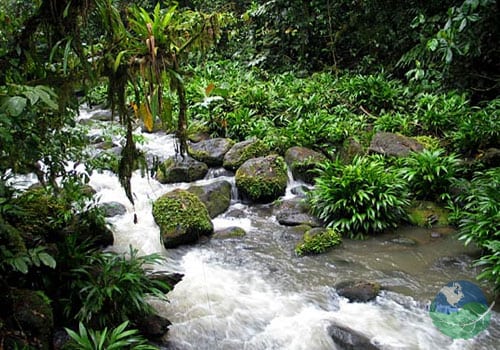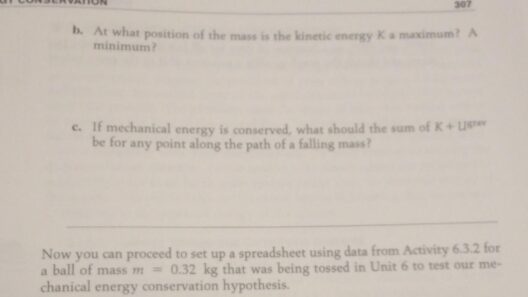In the expansive realm of physical sciences, a certain principle reigns supreme, akin to the steadfast laws of nature. This principle is known as the Law of Conservation of Energy. Though seemingly simple on the surface, its implications weave an intricate tapestry that binds together the very fabric of our universe. At its core, this law posits that energy cannot be created or destroyed; it can only be transformed from one form to another. Like a river that meanders through various landscapes, adapting and changing, energy flows through our world, perpetually in motion, yet always consistent in its essence.
To elucidate this concept, envision a cascade of water tumbling down a mountainside. As it travels, the waterfall embodies kinetic energy as gravity propels it downward. However, this energy is not lost but rather converts into other forms; as water crashes against rocks, it generates sound energy, and upon hitting the ground, it may create thermal energy through friction. Thus, the flow of energy persistently adapts, morphing into forms that serve diverse functions, yet the total amount remains constant. This beautiful interplay shapes the ecosystem around us and is fundamental to understanding various natural phenomena.
The Law of Conservation of Energy permeates every aspect of our physical environment, from the minute interactions within atoms to grand cosmic sequences. It serves as a cornerstone in the study of thermodynamics, mechanics, and various branches of physics. Exploring these intersections sheds light on how energy manifests and influences our lives.
Understanding Different Forms of Energy
Energy exists in myriad forms, each uniquely contributing to the dynamics of our world. To grasp the law’s implications fully, we must delve into the principal classifications of energy—kinetic, potential, thermal, chemical, and nuclear being just a few among many. These forms often interchange seamlessly, underscoring the law’s omnipresence.
Kinetic energy, embodying energy in motion, can be observed in a swiftly moving car or a bird soaring through the sky. Conversely, potential energy—stored energy waiting to be unleashed—can be found in a poised archer’s bow, ready to release its arrow at a moment’s notice. The moment of release transforms the stored potential energy into kinetic energy as the arrow speeds toward its target. This transformation exemplifies the fluidity of energy according to the Law of Conservation.
Furthermore, thermal energy, or heat energy, emerges from the microscopic movement of particles. A striking example is boiling water; as heat is applied, the water molecules oscillate, and the thermal energy increases until they transition into steam. The energy is not lost in this process; rather, it is exchanged, transformed, and transitioned to a different state. Understanding how energy shifts between forms is crucial in fields such as engineering and environmental science.
The Practical Implications in Everyday Life
While the Law of Conservation of Energy might seem abstract, its relevance is profoundly felt in our daily lives and pivotal scientific advancements. It influences how we approach energy resources, sustainable practices, and technological innovations.
Take, for instance, the operation of a hydroelectric dam. Water stored at height embodies gravitational potential energy. As it cascades down through turbines, that potential energy converts to kinetic energy, which then transforms into mechanical energy to churn generators, ultimately producing electrical energy. This process illustrates sustainable energy production, where the law mandates that all energy transitions follow a traceable path without loss, emphasizing the importance of renewal and conservation.
Moreover, in the realm of climate change and environmental sustainability, an understanding of energy conservation highlights the need for responsible consumption. Fossil fuels provide chemical energy that, when burned, releases heat and kinetic energy. However, the byproducts adversely affect our climate. Herein lies a poignant lesson: as we consume energy, the principle warns us to remain cognizant of conversions and transforms to optimize efficacy while preserving our precious ecosystems.
A Paradigm Shift in Energy Thinking
The Law of Conservation of Energy compels us to rethink our relationship with energy. Rather than viewing energy as an infinite resource, it encourages us to approach it as a cycle. Each energy conversion is a chance to reflect on efficiency and sustainability, much like a sustainable ecosystem that relies on the delicate balance of energy flow. Innovations in renewable energy technologies, such as solar and wind power, represent our endeavor to harmonize with this principle, harnessing natural processes that adhere to the law while mitigating environmental impacts.
In conclusion, the Law of Conservation of Energy remains an essential pillar in our understanding of the physical world, akin to a guiding compass in our exploration of science and technology. As we unravel its complexities and intertwining forms, we uncover a vast landscape filled with opportunities for innovation and sustainable practices. In recognizing the interconnectedness of energy forms, we can cultivate a mindful approach to our consumption and move towards a future that respects and harnesses the laws of nature. By doing so, we maintain our role as stewards of the planet and champions of progress, ensuring that energy continues to flow harmoniously through the tapestry of life.





